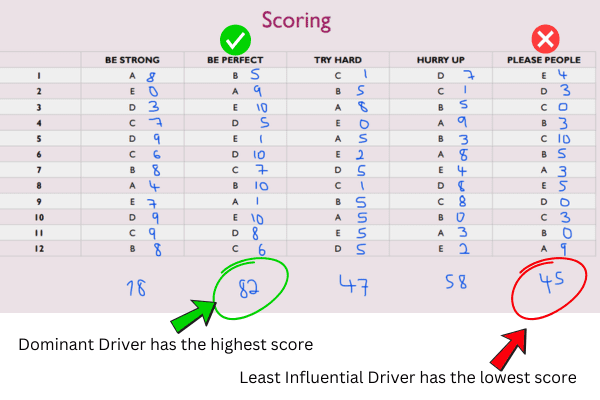Kahler’s Drivers Questionnaire
Take the Drivers Questionnaire to find out what drives you and the people you work with.
Jump Menu:
- 1-What are Drivers?
- 2-The Five Drivers Highlighted by the Questionnaire
- 3-How Do I Complete the Drivers Questionnaire?
- 4-Access Your Driver’s Questionnaire and Score Sheet
- 5-The Most Common Patterns From the Drivers Questionnaire
- 6-What Are Examples of Each Driver?
- 7-Explaining Each Driver
- 8-Insights From the Drivers Questionnaire for Managers
#1. What are Drivers?
- They are unconscious internal pressures that make us do things in certain ways, e.g. with speed, perfection, or little emotion etc.
- They’re often inappropriate or unhelpful in obtaining results, [Not always]. They tend to satisfy inner needs rather than actual events.
- They are good for identifying external signs that reflect internal processes.
#2. What are the Five Drivers Highlighted by the Questionnaire?
As the image above shows, the Five Drivers are:
- Be Perfect
- Hurry Up
- Please People
- Be Strong
- Try Hard

#3. How Do I Complete the Drivers Questionnaire?
- At a glance, you will see 12 groupings identified by numbers 1 to 12, each with 5 descriptions labelled A to E. Take each numbered section in turn, starting with the number 1.
- From each numbered section, pick out the description which is the truest for you and give it a high mark (between 7 and 10).
- Take the description that is least true for you and give it a low mark (between 0 and 3).
- Arrange the other three descriptions in between; giving each a mark which ranks them between your lowest and highest.
- Please ensure that one description is given a mark of 5.
- Scoring number one may take a little while.
- Once you get going the others will not take as long.
Sticky Learning ® is 7 times more effective than 1-day training courses. Plus, you will get a Chain of Evidence proving your Return on Investment. Discover soft skills training that changes behaviours long term.

Video Tutorial: Here’s Help If You Get Stuck!
The detailed tutorial video below shows you how to answer the questionnaire and use the score sheet to interpret your drivers.

Remember, you’re looking for something like below. Tally each column and note the totals. What were your highest and lowest scores?

Dominant Driver: The driver with the highest score is the one that most strongly influences your behaviour. This is your dominant driver.
Secondary Driver: Often, you’ll have a secondary driver that has a high score as well. People tend to have a combination of drivers rather than just one.
Least Influential Driver: The driver with the lowest score is the one that has the least impact on you. This can be insightful too, as it might suggest areas where you feel less motivated or engaged.
Bonus Resource:
You can also join this insightful training course by clicking on the banner below. Finally, learn more tips on how to engage with people of different types of preferences and more!

#4. Access Your Driver’s Questionnaire and Score Sheet Here
The whole Drivers Questionnaire should take between 20-30 minutes to complete:
Click the images below to download printable A4 PDFs.


#5. The Most Common Patterns From the Drivers Questionnaire Are:
(a) For two rather than one driver to show up strongly and this seems to fit with experience, which is that people favour a combination of Drivers rather than a single one.
(b) One of the drivers is particularly low, which is also useful feedback.
Drivers Questionnaire Scores:
- Usually range between 40 and 80.
- Anything over 80 is high.
- Only 2% have scores of over 100 or under 30.
- Any combination of drivers appears possible.
Although it would seem difficult to combine “Hurry Up” with “Be Perfect” (one intent on detail while the other is on speed) it does happen. “Be Perfect” with “Please People” would seem especially vulnerable, particularly if combined with low “Be Strong.” But they do exist. People evolve clever combinations that enable them to capitalise on their strong points and minimise their losses.
Click the image below for a higher resolution.

#6. What Are Examples of Each Driver?
Imagine you have a set of children’s building blocks and plan to make a column…
BE PERFECT:
‘I’ll have to square up the blocks exactly’ (as if perfect accuracy was important).
HURRY UP:
‘I’ll have to see how fast I can build the column’ (as if speed was important).
PLEASE PEOPLE:
‘I’ll look around to see who is watching me’ (as if their approval is important).
BE STRONG:
‘I’ll sit on the floor rather than sit at a table’ (as if the discomfort gives it added merit).
TRY HARD:
‘I’ll try it out horizontally first’ (as if the extra effort was worthwhile).
#7. Explaining Each Driver
Now you’ve completed the Drivers Questionnaire, let’s take a look in greater detail at what each driver means.
1. BE PERFECT

The basis of BE PERFECT is that every task, person, product or even statement can and should be rated as more or less good or bad.
Therefore the BE PERFECT will probably:
- Worry about getting something wrong.
- Want to work out every last detail before offering it for comment.
- Insist on getting it exactly right when a rough approximation would be more useful.
- Want to get things right the first time.
- Keep on and on to complete a job long after productive energy has been used up.
- Be well organised.
What Are the Consequences?
- Poor time planners (keeps checking when it’s no longer necessary or when people would rather see a draft quickly.)
- Checks things themselves rather than trust others.
- Hate others’ criticism: go out of their way to avoid it – it is often complicated.
- Will be driven to distraction by a HURRY UP.
BE PERFECT works well in jobs where detail is important and the set standards are important.
How Do They Improve?
- Realise that less than their best may be what is needed at the early stages.
- Realise that their qualities of accuracy and organisation may have a poor impact on others with different drivers.
How Can Managers Help Them?
Allow for and forgive:
- Mistakes
- Imperfections
- Incompleteness
2. HURRY UP

The basis of HURRY UP is that there is some additional virtue in doing something in a short time.
Therefore, HURRY UP will probably:
- Rush at things and talk rapidly.
- Interrupt and finish others’ sentences and try and do more than time allows.
- Be good in a crisis.
- Do things at the last minute.
What Are the Consequences?
- Often late and miss deadlines.
- Leave people behind (literally and metaphorically).
- Plan time badly (‘I can’t waste time’ so they rush around and don’t plan things).
- Have poor judgement over how long and how much energy jobs require.
- Prone to mistakes in terms of poor quality and inattention to detail. Likely they will be driven to despair by a BE PERFECT.
But, HURRY UP work well when ACTUALLY under time pressure because their energy will be high.
How Do They Improve?
- Think and plan ahead with regard to the REALITY of available time.
- Have short-term goals with defined standards (bite-sized jobs).
How Can Managers Help Them?
Managers can help them give themselves permission to be satisfied with what can be done comfortably within the given time.
3. PLEASE PEOPLE

The basis of PLEASE PEOPLE is that someone has to find satisfaction in you performing a task or at least should not be displeased.
Therefore the PLEASE PEOPLE will probably:
- Tend to be apologetic.
- Give way and agree relatively easily.
- Ty and avoid conflict.
- Worry about upsetting other people.
- Not begin unless someone will notice them working.
What Are the Consequences?
- Be a good team member but not a team leader.
- Go out of their way to make sure that you are happy (not always with the desired effect).
- Find confronting poor performance very difficult and can become moody and easily depressed.
- Give credit when credit is not due.
- Expect people to know what they want without telling them (clairvoyance!!).
- Appear compromising.
However, PLEASE PEOPLE can be the mortar that holds a team together. They perform the ‘maintenance’ functions of involving people, checking, summarising etc. They will be sympathetic, empathetic, tolerant and flexible.
How Do They Improve?
- Get on with things. Let actions speak for themselves.
- Turn sympathy outwards not inwards.
How Can Managers Help Them?
- Work out what they want for themselves, say what they believe, and think independently.
4. BE STRONG

The basis of BE STRONG is that something is particularly worth doing if it costs a lot. Not so much in the effort but stress, worry and near disaster.
Therefore BE STRONG will probably:
- Put a lot of pressure on themselves.
- Have the feeling that they are on the verge of cracking up or not being able to cope any more.
- Often speak in a strong voice.
- Shoulder responsibility and additional burdens well.
- Be super cool under pressure.
- Not ask for help (must cope on my own…)
What Are the Consequences?
- The BE STRONG driver is very difficult to notice externally (this difficulty is often a good sign of a BE STRONG).
- Show little outward emotion.
- Appear to have very ‘broad shoulders’, often gritty/laconic or jovial people.
- Can sap the energy of others
Remember that BE STRONG is very good at accommodating poor conditions or putting up with things that many would find unreasonable.
How Do They Improve?
- Learn to relax.
- Admit to being weak in some situations.
How Can Managers Help Them?
- Take things easy sometimes.
- Accept their emotions, for example, fear, sadness, and joy.
5. TRY HARD

The basis of TRY HARD is that it is always worth putting more, and more, and even more effort into doing something.
Therefore TRY HARD will probably:
- Puff and blow a lot.
- Have 5 projects going simultaneously.
- When talking, go on and on and on…
- Make things harder than they are.
- Spread out a task.
- Be good at hanging in there and making a lasting effort.
What Are the Consequences?
- They will digress from the vital task and dislike finishing it.
- Start things and then lose interest and energy and may not follow through on projects.
- Can sap the energy of others.
Remember the TRYHARD is very good in start-up situations and where effort and energy to complete are needed.
How Do They Improve?
- Finish some things.
- Put some full stops into their sentences.
- Follow through when necessary.
How Can Managers Help Them?
- Let things go.
- Be satisfied with little endings.
#8. What Are the Insights From the Drivers Questionnaire for Managers?
Click the image below to download a printable A4 PDF.

Summary
We hope you took valuable insight from completing the Drivers Questionnaire. Drivers give us an insight into people’s behaviour and help us to build relationships more effectively. Engage with us on LinkedIn.




